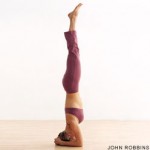 To headstand or not to headstand? That is the question and I was most amused the other day to see two opposing viewpoints one right after the other in my newsfeed on facebook. The first was a comment by one of my very favorite yoga teachers, Jenny Otto, in response to an article on not doing headstands. From her comment it is clear that she doesn’t teach headstands because of the vulnerability of the cervical spine. Enough said!
To headstand or not to headstand? That is the question and I was most amused the other day to see two opposing viewpoints one right after the other in my newsfeed on facebook. The first was a comment by one of my very favorite yoga teachers, Jenny Otto, in response to an article on not doing headstands. From her comment it is clear that she doesn’t teach headstands because of the vulnerability of the cervical spine. Enough said!
The next item on the newsfeed was ten reasons why you should do a headstand every day. I didn’t bother to read it because I know the reasons and I agree with them.
But that doesn’t mean that I teach headstands. I stopped teaching headstands as well as shoulder stands a number of years ago. Full disclosure—I love and do them both. Not every day but often enough. I definitely do plough every day though I don’t teach that either.
I stopped for two reasons. 1) I became friendly with a chiropractor who told me how many yoga students she treated with neck injuries due to poorly performed head and shoulder stands. 2) I watched a number of people with necks that I knew to be sensitive get injured because they were unable to resist trying headstands when everyone else around them was going upside down.
Inversions are great and important but there are a number of them other than head and shoulder stand that do not put pressure on the spine. For me headstands feel great. I have never had an injury that stemmed from going upside down. But I also feel that I have a solid core, well toned muscles around my shoulder blades, and fairly strong neck muscles from more advanced poses that require strength in that part of the body.
At the same time there are times that I go up and come right down. I don’t understand why but every once in a while when I go up, blood and tension seem to run into my jaw. It is a very weird feeling that implores me to come down. I usually take a few breaths in childs pose and try again but if that same thing happens I am done for the day.
The answer to the opening question seems to be maybe. Not for nothing is headstand called the king of asana but if performing them will hurt you, it would be silly to be too stubborn.
But, if you insist on doing headstands, here are a couple of tips. The L-Shaped headstand preparatory pose is a great place to start. In this pose your head will never touch the floor but you will build the muscles of your back and shoulders in order to support your future headstand. If you can do an L-shaped headstand comfortably without any struggle in the breath you should be ready to work on headstands.
When I teach people to walk I emphasize that energetically we want to be as light on our feet as possible. A happy healthy spine extends up and the extremities literally fall out towards the ground. Headstands should have the same quality. The simplest instruction I could offer if you insist on doing them is that you should be able to lift and sustain the head off of the ground while keeping your hair still touching the floor (assuming that you have hair). The ability to do this in a sustained manner would suggest that you have the ability to get that feeling of upward lift while being upside down.
***
